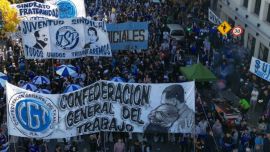February 21 might not pass into history as the October 17 of the 21st century, as its main organiser Hugo Moyano fondly imagines (an ego-massaging comparison, since enshrining the name of Juan Domingo Perón was a more permanent heritage of that red-letter day in 1945 than workingclass empowerment) but nor should it be lightly dismissed as Moyano’s lonely hearts club band, as the government sought to depict it. The Mauricio Macri administration insisted that none of the aims of Wednesday’s protest march were “clear” apart from defending Moyano against the legal charges against him by extra-judicial means – nor did the teamster help to disarm this argument since he devoted far too much of his harangue at the close of the protest to rubbishing these charges as if it were all about him. But the march’s message was perfectly clear – against Macri’s economic policies in general and the labour and pension reforms in particular – even if, as with most protests, no constructive alternative was offered. A shrewder government response might have been to highlight opposition to labour reform as a central aim of the march and then ask why none of the trade-union leadership joined the teamster beyond the bank clerks and the CTA labour umbrella (dominated by state employees), thus implying tacit approval of the reforms.
Moyano might thus be isolated among his peers but he certainly did not seem alone on Wednesday. No definite crowd numbers are possible, as ever with events like these, but splitting the difference between the 90,000 calculated by City Hall and the 400,000 claimed by the organisers to arrive at a figure of around quarter of a million would be about right (a very similar total to the original October 17, according to independent historians in an Argentina then of 15 million people). Kirchnerite, leftist and picket support all helped to round out the numbers and (with the possible exception of the former) these strands might well represent the future face of social protest more than trade-union dinosaurs defending the dead-end jobs of import substitution against robots in order to line their own pockets. In this sense, perhaps Moyano was almost alone on Wednesday.
Much like Senator Cristina Fernández de Kirchner, Moyano has been presented as larger than life by the government as an easily demonised alternative but who is he and what does he represent? As an individual, he’s had a remarkable evolution from trade unionist to businessman – after taking teamster membership up from 27,000 to 220,000 in his 27 years at the union helm (at huge cost to Argentina’s infrastructure by destroying rail freight), he has branched out into such diverse lines as Independiente football club and OCA couriers, now apparently within days of collapse. Yet the heavyweight union clout he represents has deepened more than reversed social inequality – the working-class may not have gone to paradise in Argentina but after long years of collective bargaining and inflation feeding each other, unionised employees often earn more than most middle-class sectors while pushing a third of the population into poverty. And it is these excluded who may come to represent the true significance of February 21 more than Moyano’s courtroom cases.
To conclude on a positive note, it was a peaceful protest – no small mercy after December’s traumas. And peaceful because both sides wished it so. The government’s motives are obvious – it is hard to imagine the Wall Street Journal article floating the possibility of Macri’s early exit being published before the December 18 chaos and the ruling coalition wanted no repeat. At the same time Moyano had no wish to deepen his isolation by letting his march degenerate into extremist violence. In this sense February 21 testified to polarisation, but also its opposite.





















Comments